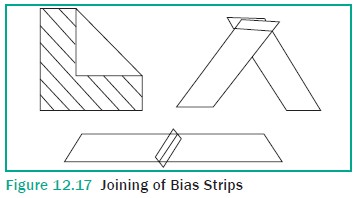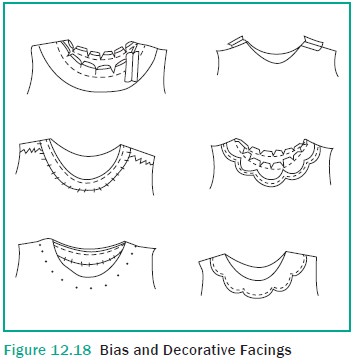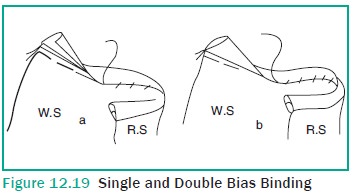Sewing - Neckline Finishing | 11th Textiles and Dress Designing : Chapter 12 : Basic Sewing
Chapter: 11th Textiles and Dress Designing : Chapter 12 : Basic Sewing
Neckline Finishing
Neckline Finishing
Finishing of the neckline is of great importance. It affects the final appearance of the garment and also undergoes much strain while wearing the dress especially dresses without fasteners. Hence the neckline finish must be stronger. Neckline finish increases the durability of the garment. It should retain the shape and size. Mostly bias strips are used to finish the necklines, because of its stretchability. Most necklines are finished in one of the following three ways :
· With facings.
· With bindings.
· With a collar.
The major points to be considered while finishing the neckline are :
· Neckline edges must retain shape and must not stretch (curves & corners).
· Seam must be thin and smooth.
· Facing edges must be beneath the collar/neckline .
Bias Piece
A true bias is a diagonal line at 45o to the lengthwise or crosswise grain. It has the maximum elasticity more than any other direction in the cloth. Bias stripes can be applied as facings and bindings and espe-cially used for finishing curved edges such as neckline, sleeveless, armholes and scallops.
Cutting Bias Strips
Fold the fabric diagonally so that the lengthwise threads of the folded part fall parallel to the crosswise threads on the rest of the material. Using a ruler, measure from the fold to desired width of bias strip (usually 2- 2.5 cm) and draw parallel lines. Cut along the marked lines and trim off ends along the warp threads.
Joining of Bias Strips
Place the bias stripes with their right sides facing each other. The edges of the cut ends should coincide. Shift the top strip 0.5 cm beyond the other so that the sharp points at the ends of the strips project on either side. Stitch a 0.5 cm seam joining the points where the sides of the two stripes intersect. Press the seam open and trim the seam projection (Figure 12.17).

Facing
Facing are used to provide a neat finish to the raw edges in a garment. It also sup-ports the shape of a neckline, armhole and collars. When the neckline is straight, the facing must be cut in one piece with the garment section. If the shape is curved, the facing must be cut in bias. Facing may appear on the right side of the garment and the colour of the facing should match with the colour of the garment fabric. Decorative facings are usually made with scalloped points or other designs along the outer edge. Bias facings can be applied on the right side of the garment for deco-rative effects (Figure 12.18).

Bindings
Bias binding is used to finish and strengthen raw edges and to add decorative trim to a garment. It shows both on the right and wrong side of the garment. When finished, bias binding should have uniform width (less than 0.25 cm) and should lie flat and smooth without any stitches showing on the right side of the garment. There are two kinds of bias binding, Single bias binding and French binding or piping (Figure 12.19).

Related Topics